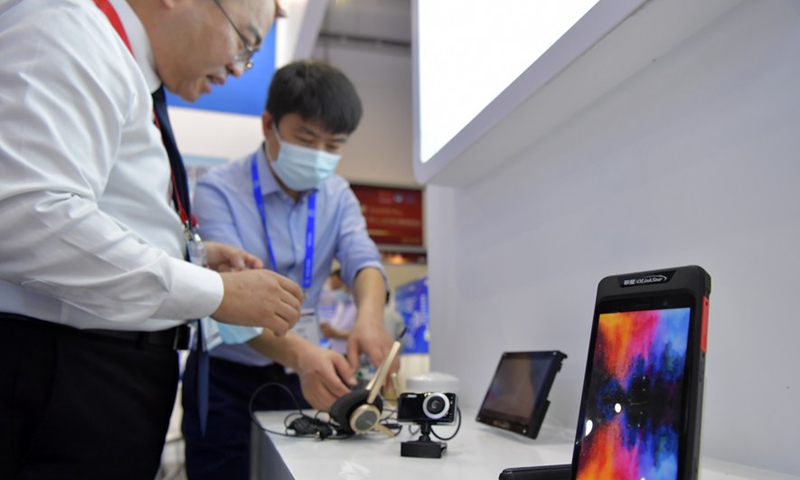
Photo taken on May 27, 2021 shows a smartphone based on the BeiDou Navigation Satellite System, which can be applied to disaster relief operations in uninhabited regions, during the 12th China Satellite Navigation Expo (CSNE) in Nanchang, capital of east China's Jiangxi Province. (Xinhua/Peng Zhaozhi)
With more Chinese phonemakers and chip producers mulling the launch of satellite-enabled terminals following moves by Huawei and Apple, the race among tech companies to connect phones to non-terrestrial networks is set to intensify, industry analysts said, which is conducive to narrowing the gap with the US in the commercialization of low-Earth orbit satellite constellations.
Shares in the satellite navigation segment opened higher on Thursday. At Wednesday's closing, the index of satellite navigation shares had risen 4.77 percent, and the index of satellite internet shares was up 5.75 percent, since the start of September, far outperforming the overall A-share market with the benchmark Shanghai Composite Index up 0.1 percent.
The recent frenzy in the satellite sector across the A-share board was triggered by the Mate 60 pro, Huawei's latest flagship mobile phone, which is the world's first phone model with satellite calling features for the mass market.
The phone is powered by the Tiantong-1 communications satellite system, which currently has three satellites operating in orbit. China Telecom, one of the country's three mobile carriers, is the sole operator of the satellite services.
During Tuesday's Apple fall launch event, Apple announced it is adding satellite-powered roadside assistance to the iPhone, although the function is not available for users in China.
"The function of making satellite calls has become a new innovation focus for smartphone vendors amid the sluggish shipment of phones in global markets," Huang Haifeng, an independent tech analyst, told the Global Times on Thursday.
Under this circumstance, upstream manufacturers have an urgent need for technological breakthroughs and rolling out high-end products, he noted.
A direct connection between smartphones with satellites without the support of terrestrial networks means that at any place on Earth, communications with satellites can be achieved by just a phone instead of through large ground equipment or base stations.
The satellite is responsible for receiving and forwarding signals. During the communication period, users can move anywhere on Earth.
Compared with traditional satellite communication terminals that are heavy and big, satellite-enabled phones need to make breakthroughs in such technologies as downsizing the antenna so that it can be put into a phone, Huang said.
He predicted that more domestic vendors will roll out satellite-feature phones in the coming months as they are all betting on the prospective sector.
Apart from phone vendors, chipmakers are also doubling down on efforts for satellite chips.
In June, US chip giant Qualcomm Technologies announced the introduction of two modem chipsets that come equipped with satellite capability.
With more market players joining the race, it will help promote the commercialization of the satellite industry, building a more prosperous commercial space sector in China, industry insiders said.
Xie Tao, founder and CEO of satellite producer Commsat, told the Global Times on Thursday that direct phone-satellite connections provide an opportunity for China to get ahead of the curve when it comes to comparison with the leading US role in the world thanks to Elon Musk's satellite-based Starlink constellation internet.
"China is temporarily lagging behind due to insufficient domestic demand scenarios. In comparison, Starlink has been implemented on a large scale overseas.
"However, China is the only rival with the US in this field because the former has built up a basically well-established and complete commercial aerospace industry chain," Xie noted, adding that the two powers' gap in this field is narrowing.
In July, state-owned China Aerospace Science and Industry Corp (CASIC) announced the official start to the construction of an ultra-low-Earth orbit satellite constellation, which can provide effective data support for emergency rescue, fire monitoring and disaster prevention and alleviation.
The first satellite of the ultra-low-Earth orbit satellite constellation will be launched in December, according to the contractor.
The advance of 6G is also expanding space in the future satellite communications technology.
"The ultimate goal is to directly connect to low-Earth orbit satellites to achieve various services such as calls and internet access without modifying any smartphones, that is, without adding any antennas to the smartphones, and the premise is 6G, through which a space-air-ground integrated network is workable," Xie said.
"6G will be commercially available around 2030 in China, and 3GPP (an international organization on telecom technology development) is expected to start 6G standardization in 2025," Huang Yuhong, general manager of the China Mobile Research Institute, told the Global Times previously.
In mid-April, China made a breakthrough in 6G research, using terahertz orbital angular momentum for the first time to conduct a real-time wireless transmission communication experiment.




